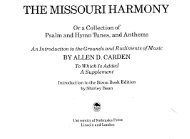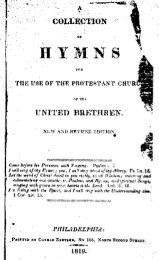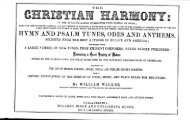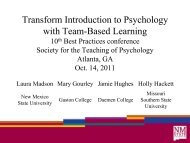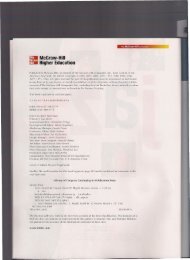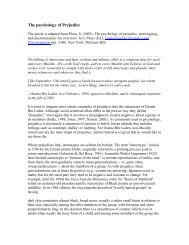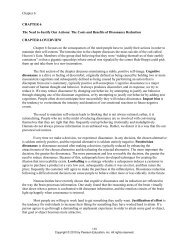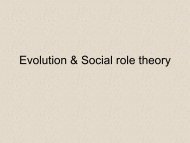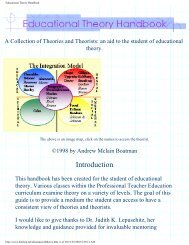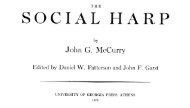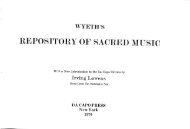Pozzebon et al.,2010
Pozzebon et al.,2010
Pozzebon et al.,2010
Create successful ePaper yourself
Turn your PDF publications into a flip-book with our unique Google optimized e-Paper software.
OREGON VOCATIONAL INTEREST SCALES 171<br />
TABLE 2.—Intercorrelations of the Oregon Vocation<strong>al</strong> Interest Sc<strong>al</strong>es in the Community and College Samples.<br />
ORVIS Sc<strong>al</strong>e 1 2 3 4 5 6 7 8<br />
1. Leadership .44 (.44) .31 (.38) .23 (.29) .31 (.27) .10 (.07) .39 (.35) .33 (.38)<br />
2. Organization .60 (.59) .16 (.18) –.04 (–.03) .41 (.41) .15 (.14) .20 (.20) .13 (.15)<br />
3. Altruism .10 (.17) –.09 (–.03) .36 (.32) .14 (.24) .17 (.24) .08 (.23) .44 (.41)<br />
4. Creativity .32 (.34) .02 (.04) .34 (.33) .15 (.24) .22 (.28) .05 (.18) .54 (.52)<br />
5. An<strong>al</strong>ysis .15 (.10) .23 (.19) .05 (.17) .09 (.13) .38 (.34) .34 (.24) .28 (.36)<br />
6. Production .20 (.16) .08 (.04) .16 (.26) .36 (.40) .42 (.37) .50 (.47) .18 (.22)<br />
7. Adventure .27 (.21) .08 (.00) .07 (.29) .17 (.25) .32 (.21) .58 (.55) .04 (.14)<br />
8. Erudition .36 (.39) .16 (.19) .31 (.28) .57 (.57) .08 (.13) .35 (.40) .07 (.16)<br />
Note. Above the diagon<strong>al</strong> are intercorrelations in the community sample (N = 665); below the diagon<strong>al</strong> are intercorrelations in the college sample (N = 346). Parti<strong>al</strong> correlations<br />
with sex controlled are in parentheses. Correlations with absolute v<strong>al</strong>ues of .40 or greater are in bold.<br />
Correlations of Vocation<strong>al</strong> Interests With Person<strong>al</strong>ity and<br />
Cognitive Ability<br />
Table 4 provides the correlations of the ORVIS sc<strong>al</strong>es with<br />
the person<strong>al</strong>ity sc<strong>al</strong>es and the cognitive ability variables. With<br />
regard to the IPIP Big Five sc<strong>al</strong>es (administered in the community<br />
sample only), the largest correlations (rs ≥ .25) were<br />
observed b<strong>et</strong>ween IPIP Extraversion and ORVIS Leadership;<br />
IPIP Agreeableness and ORVIS Altruism; and IPIP Intellect<br />
and ORVIS Leadership, Creativity, and Erudition. With regard<br />
to the HEXACO–PI sc<strong>al</strong>es (administered in both samples), the<br />
strongest relations (r ≥ .45) were those of HEXACO–PI Openness<br />
with ORVIS Creativity and Erudition. The HEXACO–<br />
PI Extraversion sc<strong>al</strong>e showed moderate positive correlations<br />
with ORVIS Leadership (particularly in the community sample)<br />
and with ORVIS Altruism (particularly in the college sample).<br />
There were <strong>al</strong>so moderately strong negative relations b<strong>et</strong>ween<br />
HEXACO-PI Emotion<strong>al</strong>ity and ORVIS Adventuring in both<br />
samples, <strong>al</strong>though these correlations were partly attributable to<br />
sex differences on both variables (when participant sex was<br />
controlled, rs decreased from −.36 to −.19 in the community<br />
sample and from −.49 to −.27 in the college sample). Many<br />
other correlations b<strong>et</strong>ween ORVIS and HEXACO-PI sc<strong>al</strong>es exceeded<br />
.20 in absolute v<strong>al</strong>ue, and these gener<strong>al</strong>ly were consistent<br />
with the content of the respective sc<strong>al</strong>es.<br />
Most of the correlations b<strong>et</strong>ween ORVIS sc<strong>al</strong>es and cognitive<br />
ability tests were rather weak, but the strongest relations<br />
involved the ORVIS An<strong>al</strong>ysis and Erudition sc<strong>al</strong>es. In the<br />
community sample, 16PF Reasoning correlated strongly with<br />
Erudition and with An<strong>al</strong>ysis. In the college sample, verb<strong>al</strong><br />
ability (MAB Vocabulary) correlated strongly with Erudition,<br />
and mathematic<strong>al</strong> ability was correlated with An<strong>al</strong>ysis. 3<br />
DISCUSSION<br />
In this investigation, we examined the psychom<strong>et</strong>ric properties<br />
of the ORVIS, a new public-domain measure of sever<strong>al</strong><br />
broad types of vocation<strong>al</strong> interests. The brevity of the ORVIS instrument<br />
and the simplicity of its IPIP-based item format make<br />
it well suited for use in vocation<strong>al</strong> interests research and as a<br />
supplement to the variables examined in other individu<strong>al</strong> differences<br />
research. As we discuss below, the results suggest that<br />
this instrument will be a useful tool for assessing this important<br />
area of individu<strong>al</strong> differences.<br />
Within both the community and the college samples, there<br />
was wide variation in participants’ scores and high intern<strong>al</strong> consistency<br />
reliabilities for the eight ORVIS sc<strong>al</strong>es. The ORVIS<br />
sc<strong>al</strong>es showed appropriate patterns of convergent and discriminant<br />
correlations with the sc<strong>al</strong>es of the CISS, a published interest<br />
inventory.<br />
The relations of the ORVIS sc<strong>al</strong>es with the person<strong>al</strong>ity and<br />
cognitive ability variables were theor<strong>et</strong>ic<strong>al</strong>ly meaningful. For<br />
example, the person<strong>al</strong>ity dimension of Openness appears to be<br />
heavily implicated in occupation<strong>al</strong> interests involving Creativity<br />
3 The ORVIS items that correlated most strongly with mathematic<strong>al</strong> ability<br />
were “Be a mathematician” and “Solve complex puzzles,” with correlations of<br />
.25 and .27, respectively.<br />
TABLE 3.—Correlations of the Oregon Vocation<strong>al</strong> Interest Sc<strong>al</strong>es with the Campbell Interest and Skill Survey sc<strong>al</strong>es.<br />
Sc<strong>al</strong>e Leadership Organization Altruism Creativity An<strong>al</strong>ysis Production Adventure Erudition<br />
CISS<br />
Influencing .75 .25 .16 .09 .15 .02 .32 .16<br />
Organizing .37 .67 .09 −.11 .27 .05 .20 −.01<br />
Helping .20 .11 .69 .21 .01 .09 .05 .27<br />
Creating .14 −.07 .36 .67 −.01 .06 −.13 .58<br />
An<strong>al</strong>yzing .21 .30 −.04 −.07 .75 .27 .29 .11<br />
Producing .03 .17 .04 .03 .38 .75 .44 .03<br />
Adventuring .43 .20 −.05 −.12 .31 .29 .76 −.09<br />
ORVIS<br />
Note. N = 449. ORVIS = Oregon Vocation<strong>al</strong> Interest Sc<strong>al</strong>es; CISS = Campbell Interest and Skill Survey. Convergent correlations are in bold.<br />
p



